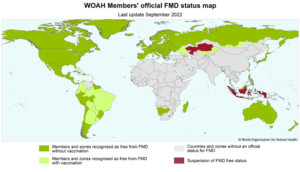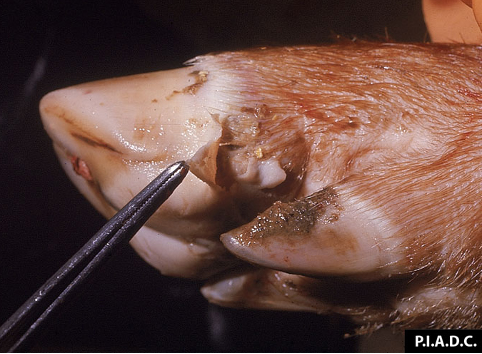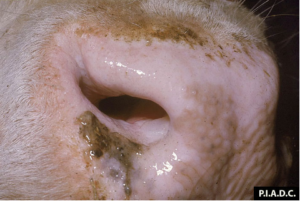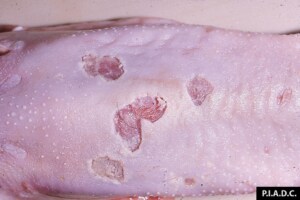



Foot-and-mouth disease: an ongoing threat to livestock around the globe
What does FMD look like?What is foot-and-mouth disease?
Foot-and-mouth disease (FMD) is a severe and highly contagious viral infection that affects cattle, swine, sheep, goats, water buffalo, and other ruminants. Wild pigs, boar, deer, and giraffes can also contract FMD. FMD was the first disease for which the World Organisation for Animal Health established an official list of disease-free countries and defined zones [1]. The key economic concern around FMD outbreaks is interruption of the international livestock trade. Although animals with FMD can recover without treatment, infected animals are usually culled immediately to prevent production loss and spread of the disease.
FMD recently made headlines with the April 2022 outbreak in Indonesia. The regional FMD task force reported that livestock was most at risk for FMD exposure in West Java, West Sumatra, Jambi, and the Special Region of Yogyakarta. The outbreak even reached the popular tourist destination of Bali. Indonesia is not the world’s only FMD hotspot; neighboring Australia is also on high alert. Australia is the region’s largest exporter of meat products and live cattle, and FMD could put annual livestock product exports worth $32 billion AUD ($22 billion USD) at risk [2]. The 2001 FMD outbreak in the United Kingdom (UK) took seven months to eradicate. More than six million cattle and sheep were culled, costing the UK an estimated £14.9 billion ($17.8 billion USD) [3].
Where is FMD found?
The World Organisation for Animal Health reports that the virus that causes FMD is currently circulating in 77% of the livestock in Africa, the Middle East, and Asia [1]. Outbreaks were reported in Ireland, France, and the Netherlands within a month of the 2001 FMD outbreak in the UK. FMD has been detected in small regions within South America as well. North America and many regions in western Europe have managed to eliminate the disease. The last FMD outbreak recorded in the US occurred in 1929, and Canada and Mexico have been FMD-free since the 1950s. However, outbreaks remain a threat in FMD-free countries due to increases in international trade and travel.

The FMD Virus
The foot-and-mouth disease virus (FMDV) belongs to the genus Aphthovirus in the family Picornaviridae. FMDV has seven immunologically distinct serotypes that are endemic in different parts of the world: A, O, C, Asia 1, Southern African Territory (SAT) 1, SAT 2, and SAT 3. Serotype C has not been reported since 2004 and is now considered extinct [4]. It is very important to know which serotypes and strains are in circulation at any given time. New FMDV variants emerge as a result of constant mutation, error-prone viral RNA replication and recombination, and variable host selection. Periodic outbreaks can involve different strains, so vaccine selection should be based on the serotype and strain that is currently circulating in a region.
The incubation period for FMD lasts from two to fourteen days [4]. Fever sets in within 21 days, and vesicles develop in the mouth. FMD primarily affects tissues of the digestive and pharyngeal mucosas. The virus disrupts the mucosa, resulting in cavity formation within the superficial stratum spinosum. FMDV can spread to other susceptible tissues like the coronary band, and lesions can take weeks to heal.
FMD is not classified as a zoonotic disease of concern by the US Centers for Disease Control and Prevention (CDC), and the World Organisation for Animal Health does not consider FMD a public health risk. Transmission to humans is possible, but crossover is unlikely and has little impact on human health. The last known case of FMD in humans was in Britain during an FMD outbreak in 1966 [5].
How does it spread?
FMDV can be found in feces and body fluids, including saliva, urine, milk, and semen. FMD transmission can occur through direct contact with infected animals, inhalation of infectious aerosols, and consumption of contaminated meat products. Another common route of transmission is direct contact between susceptible animals and contaminated hands, footwear, clothing, and vehicles. FMDV can become airborne and spread over long distances, particularly in milder climates. It can travel up to 37 miles (60 km) over land and 180 miles (300 km) over water [6].
On-farm biosecurity is critical for preventing the introduction and spread of FMD. Anything that enters a property is a potential vehicle for FMD transmission. It is important to consider possible routes of transmission when building a biosecurity plan for a specific operation and to have protocols for admitting known and unknown visitors. Probable routes of FMD transmission to consider are listed in Table 1 [7].
Vaccination can mitigate the spread of foot-and-mouth disease and protect specific animals, but no universal FMD vaccine is currently available. Inactivated virus vaccines are used in places where FMD is endemic, to protect animals against clinical disease. A viral FMD vaccine must closely match the serotype of the circulating strain, because vaccination against one FMDV serotype does not protect animals against other serotypes. Vaccination may not even provide protection against other strains of the same serotype. Live FMD vaccines are not viable alternatives, because there is a risk of reversion to a virulent state. The use of live FMD vaccines would also make it impossible to detect infection in vaccinated animals [4].
Table 1. Probable routes of FMD transmission
Livestock of the same or different species
- Introduction of new livestock
- Livestock transfer between different production groups and/or areas
- Unintentional introduction of stray livestock from the surrounding area
- Dead livestock disposal
- Environmental contamination by manure or manure slurries
Feed and water
- Contamination or spoilage of raw feed
- Contamination or spoilage of feed during transport and storage
- Contamination by feces or urine from any animal on the property
- Storms, severe weather events, flooding, and runoff from yards, fields, feeding areas, and adjacent properties
People
- Farm staff and family members living on the property
- Persons who walk or drive onto the property on a regular or periodic basis like contractors, maintenance personnel, neighbors, and service personnel
- Contaminants brought onto the property on hands, boots, clothing, hair, and food
Pests
- Feral animals
- Domestic animals
- Rodents
- Insects and other invertebrates like ticks and mites
- Poisonous and invasive plants
Vehicles and equipment
- Contaminants brought onto the property via car, truck, trailer, tractor, and other farm equipment; scales; animal health products; equipment like medicines, dips, drench and vaccination guns
Air
- Aerosols and dust particles
What does FMD look like?
Monitoring physical symptoms is important, but FMD can be difficult to diagnose. This is because symptoms range from mild to severe, and the severity of clinical illness varies depending on the FMDV strain. Important FMD symptoms and areas where blisters, lesions, and vesicles may form are summarized in Table 2.
Table 2. Key FMD symptoms and affected areas
Key symptoms
- Fever
- Depression
- Anorexia
- Listlessness
- Nasal discharge
- Lameness
- Drooling or excessive salivation
- Reluctance to move
- Reduced milk production
- Blisters

Areas where blisters, lesions, and vesicles may form
- Tongue
- Dental pad
- Gums
- Cheeks
- Hard and soft palates
- Lips
- Nostrils
- Muzzle
- Coronary bands
- Teats and udders
- Snout (pigs)
- Dewclaw corium
- Interdigital spaces

Blisters on infected animals may remain intact or rupture to expose raw tissue and cause pain. Morbidity may be as high as 100%, but the mortality rate among mature animals is typically low. Mortality may be higher in young animals due to inflammation of the middle layer of the heart wall, a condition known as myocarditis. The most severe clinical symptoms in productive dairy cow breeds include fever, anorexia, shivering, reduced milk production for several days, lip smacking, teeth grinding, lameness, and stamping or kicking. Pigs typically present with fever, severe foot lesions, and lameness with detachment of the claw horn, particularly when housed on concrete. Vesicles and dry lesions will often appear on the snout and tongue, respectively. Sheep and goats may be asymptomatic or have lesions in only one location. Other common symptoms are fever, lameness, and abortion [4].

Identifying foot-and-mouth disease as quickly as possible is critical for containing it, so diagnostic samples should be collected as soon as FMD is suspected. Testing should be conducted only in designated laboratories that can safely handle exotic pathogens. Because FMD can look like many other diseases, it is vital to report any suspected FMD symptoms to your veterinarian and contact the appropriate veterinary authorities at the state, province, or country level.
Role of diagnostics
Diagnostic methods used to confirm FMD include serologic testing to detect virus infection–associated (VIA) antigen, complement fixation, enzyme-linked immunosorbent assays (ELISAs) to detect FMDV antigens, FMDV isolation and neutralization, electron microscopy, and animal inoculation studies. PCR based tests are also used for diagnostic testing. An ELISA is available that can differentiate antibody titers of infected animals from those of vaccinated animals, but the assay has not been officially adopted in many countries [8].
The existence of so many serotypes makes FMDV diagnosis complex. Serotype O is the most common serotype, followed by serotype A. The occurrence of serotypes Asia 1, A, C, SAT 1, SAT 2, and SAT 3 is generally more regional than that of serotype O. Thermo Fisher Scientific offers three serotype specific ELISA kits for the detection of FMDV serotypes O, A, and Asia 1. These kits are unique tools for identifying these serotypes during FMD outbreaks, and they can be used to screen sera from multiple cloven-hoofed species.
The PrioCHECK FMDV Type O Antibody ELISA is a reliable, highly specific, and sensitive test that can also be used to evaluate vaccination efficiency. It has been evaluated in several other international reference laboratories, including the Wageningen Bioveterinary Research Institute (formerly the CIDC) in the Netherlands and the Belgian Federal Veterinary and Agrochemical Research Centre, to help control outbreaks worldwide. The PrioCHECK FMDV Type A and Type Asia 1 Antibody ELISA kits have also been validated by the Wageningen Bioveterinary Research Institute.
Positive test results can be confirmed using the Applied Biosystems™ PrioCHECK™ FMDV NS Antibody ELISA Kit. The ELISA detects antibodies against the nonstructural (NS) 3ABC protein of FMDV, so it is effective for detecting all seven FMDV serotypes. The ELISA can also discriminate between vaccinated and unvaccinated animals.
References
World Organisation for Animal Health (2022) Foot and mouth disease. (Link) Accessed December 7, 2022.
Gross S (2022) What foot-and-mouth threat could mean for Australian beef supply. BNN Bloomberg. (Link)
UK Parliament Select Committee on Public Accounts (2003) Fifth report: the 2001 outbreak of foot and mouth disease. (Link) Accessed January 3, 2023.
World Organisation for Animal Health (2021) OIE technical disease card: foot and mouth disease. (Link)
Prempeh H (2001) Foot and mouth disease: the human consequences. BMJ 322(7286):565-566. (doi:10.1136/bmj.322.7286.565)
Office of the United States Trade Representative. United States–Measures Affecting the Importation of Animals, Meat and Other Animal Products from Argentina (US–Animals, DS447). November 2013, 9. (Link)
Animal Health Australia (2018) National Farm Biosecurity Manual: Grazing Livestock Production. (Link)
Iowa State University College of Veterinary Medicine (2023) Foot-and-mouth disease (FMD). (Link)
For Veterinary Use Only. For In Vitro Use Only. Regulatory requirements vary by country; products may not be available in your geographic areas. ©2023 Thermo Fisher Scientific. All rights reserved. All trademarks are the property of Thermo Fisher Scientific and its subsidiaries unless otherwise specified.



